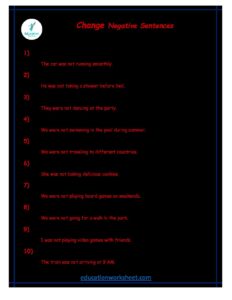Change Simple Present tense to Past Continuous tense 20 worksheets
Mastering the Transformation from Change Simple Present to Past Continuous Tense
Description:
Understanding the nuances of verb tenses is essential for effective English communication. One significant shift in tenses is from Change Simple Present tense to Past Continuous tense, and in this detailed guide, we will explore how to make this transformation. By mastering the conversion of Change Simple Present tense to Past Continuous tense sentences into past continuous tense, you can significantly enrich your ability to describe actions in the past with a focus on their duration and continuity.
A Brief Overview of Tenses:
Before diving into the transformation of Change Simple Present tense to Past Continuous tense to past continuous tense, let’s recap what each tense represents:
- Simple Present Tense: This tense is used to describe actions or situations that are habitual, regular, or generally true. It often employs the base form of the verb.
- Past Continuous Tense: Also known as the past progressive tense, this tense emphasizes actions that were ongoing or in progress at a specific point in the past. It is formed by using the past tense of the verb “to be” (was/were) and adding the base form of the main verb with “-ing.”
Simple Present to Past Continuous Tense
Changing simple present tense sentences into past continuous tense involves specific rules and structures. Let’s break it down step by step:
- Identify the Simple Present Sentence: Begin by recognizing the simple present tense in a sentence. It typically contains a subject, a verb (often in its base form), and may include time markers like “always,” “usually,” or “every day.”
- Select the Appropriate Past Continuous Form: To convert the sentence, determine the Change Simple Present tense to Past Continuous tense of the verb “to be” based on the subject. Use “was” for singular subjects (I, he, she, it) and “were” for plural subjects (you, we, they).
- Change the Main Verb: Replace the base form of the main verb with the “-ing” form to indicate that the action was ongoing in the past.
- Maintain the Context: Keep the context of the sentence consistent with the intended meaning. Ensure that it describes an action that was happening at a specific point or during a particular period in the past.
Examples and Explanations

Let’s illustrate the transformation with some examples:
Simple Present: He plays basketball every Saturday.
Past Continuous: He was playing basketball every Saturday.
- Explanation:
- Simple Present: “plays” (base form of the verb)
- Past Continuous: “was playing” (past tense of “to be” + base form of the main verb + “-ing”)
Simple Present: They watch movies at night.
Past Continuous: They were watching movies at night.
Change simple present tense to past perfect continuous form negative

- Explanation:
- Simple Present: “watch” (base form of the verb)
- Past Continuous: “were watching” (past tense of “to be” + base form of the main verb + “-ing”)
Simple Present: She reads books on Sundays.
Past Continuous: She was reading books on Sundays.
- Explanation:
- Simple Present: “reads” (base form of the verb)
- Past Continuous: “was reading” (past tense of “to be” + base form of the main verb + “-ing”)
Why Is This Change Simple Present tense to Past Continuous tense Important?
Understanding how to change from simple present to past continuous tense is crucial for conveying a more vivid and detailed account of events in the past. It allows you to emphasize the duration, ongoing nature, or background action during a particular time frame. This can significantly enhance your storytelling and communication skills in both written and spoken English.
Practical Application:
To reinforce your grasp of this transformation, practice is key. Here are some exercises and worksheets to help you:
Worksheet 1: Fill in the Blanks
- Exercise: Complete the sentences by Change Simple Present tense to Past Continuous tense into past continuous tense.
- Example: She __________ (read) a book when the phone rang.
- Solution: She was reading a book when the phone rang.
Worksheet 2: Create Your Own Sentences
- Exercise: Use the given subjects and verbs to create your own sentences in the past continuous tense, describing actions in the past.
- Example: He / cook
- Solution: He was cooking.

Worksheet 3: Change Simple Present tense to Past Continuous tense the Sentences
- Exercise: Rewrite the given sentences, changing them from simple present to past continuous tense.
- Example: They play soccer in the park every Sunday.
- Solution: They were playing soccer in the park every Sunday.

